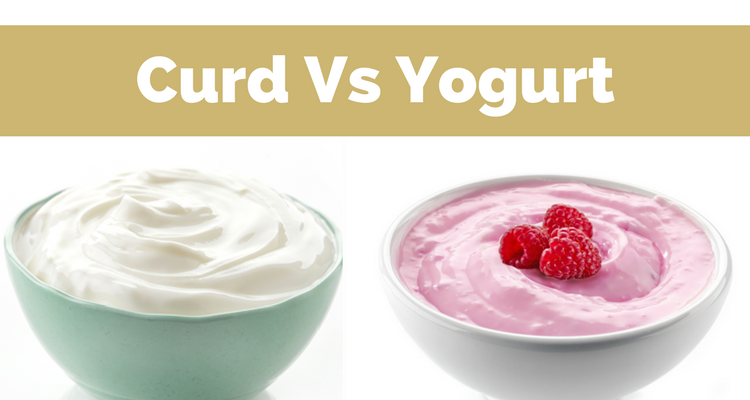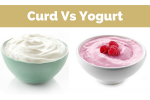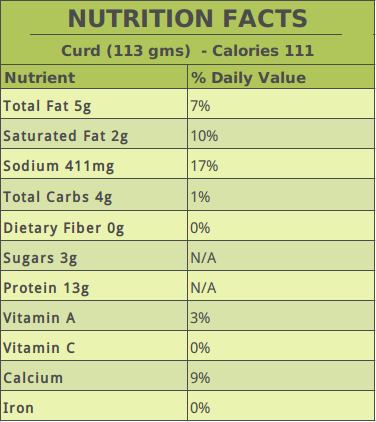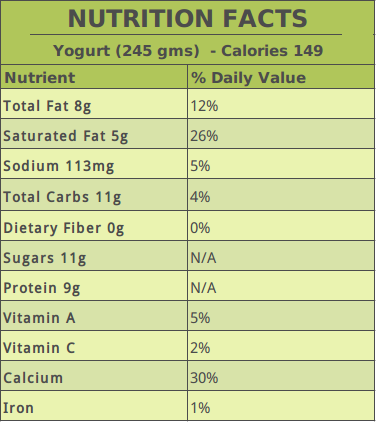
Curd and yogurt are two interchangeable terms, or so most of us think. They are almost similar, and yet, are different types of dairy products. Curd refers to milk solids obtained by adding an acidic curdling agent to the milk. In contrast, yogurt is made by fermenting boiled and cooled milk with a live bacterial culture and letting it solidify. In this article, we will discuss the nutrition facts and health benefits, as well as how to make curd vs. yogurt.
The difference between curd and yogurt lies in their formulation. The process of fermentation is required to make yogurt, whereas curd is made using the curdling technique. We will explain this further along in the article.
Curd vs. Yogurt Nutrition Facts
Curd Nutrition Chart
Although they may look similar, the nutritional values of curd and yogurt are different. Let’s take a look at a standard serving size of 100 grams of both curd and yogurt.
Yogurt Nutrition Chart
Curd vs. Yogurt Calorie Content
A serving of 100 grams of curd provides 98 calories, of which 38 calories come from fat. The same serving size of yogurt will give about 61 calories with 29 calories from fat.
Curd vs. Yogurt Fat Content
A 100-gram serving of curd has four grams of total fat, of which two grams is saturated fat. The same serving size of yogurt provides three grams of total fat, and two grams of it is saturated fat. So, comparatively, yogurt contains more saturated fat than curd. Both curd and yogurt contain trace amounts of good fats, or omega-3 and omega-6 fatty acids.
Curd vs. Yogurt Protein Content
A 100-gram serving of curd offers 11 grams protein, while the same serving size of yogurt has only three grams of protein. Both these foods contain all the amino acids required by the human body for optimum tissue health.
Curd vs. Yogurt Carbohydrate Content
The total carbohydrates in 100 grams of curd are three grams, while 100 grams of yogurt offers five grams. The carbohydrates found in yogurt is mostly sugar in the form of lactose.
Curd vs. Yogurt Vitamin and Mineral Contents
Curd and yogurt are good sources of essential vitamins and minerals. A 100-gram serving size of curd contains 10% DV of riboflavin, seven percent DV of vitamin B12, six percent DV of pantothenic acid, three percent DV of vitamin A, and two percent DV of thiamin and vitamin B6. It also contains 16% DV of phosphorus, 15% DV of sodium, 14% DV of selenium, eight percent DV of calcium, three percent DV of potassium and zinc, two percent DV of magnesium, and one percent DV of copper.
In comparison, a 100-gram serving of yogurt contains eight percent DV of riboflavin, six percent DV of vitamin B12, four percent DV of pantothenic acid, and two percent DV of vitamin A, thiamin, folate, and vitamin B6. Vitamin C is also present in trace amounts. In terms of mineral content, yogurt contains 12% DV of calcium, nine percent DV of phosphorus, four percent DV of potassium and zinc, three percent DV of selenium and magnesium, and two percent DV of sodium.
Therefore, from the above comparison between curd vs. yogurt regarding their nutrient content, both are healthy foods that you can include in your diet on a daily basis.
Curd vs. Yogurt Benefits on Health
Curd and yogurt are widely popular dairy products. Both curd and yogurt are healthy dairy products that can satisfy your sweet or snack craving in a healthy way. Here is a comparison of the health benefits of curd vs. yogurt.
1. Improves digestion
The digestive system absorbs the nutrients in curd easily. These nutrients also help absorb nutrients from other foods as well. Curd also helps neutralize the heat produced by spicy foods, and thus, it is a part of most Indian dishes. A Taiwanese study found that curd is a helpful agent in curing H. pylori infections, commonly known as peptic ulcers.
Yogurt, specifically the probiotic types, benefits the digestive system. It contains beneficial bacteria like bifidobacteria and lactobacillus that provide comfort to patients with irritable bowel syndrome (IBS). Medical studies revealed that fermented yogurt with bifidobacteria could effectively curb bloating, and improve stool frequency in IBS patients.
2. Strengthens bones
Both curd and yogurt contain calcium since their source of origin is milk and can be fortified with vitamin D. Other nutrients that curd and yogurt are rich in are protein, potassium, phosphorus, folate, and vitamin B12 among others. All of these minerals work in close association to boost bone health. Individuals suffering from low bone density can reduce the risk of osteoporosis by regular curd or yogurt consumption.
3. Benefits heart health
Curd and yogurt are rich in good fats that contribute to heart health. Medical research shows that saturated fat from whole milk products may increase high-density lipoprotein (HDL) or “good” cholesterol and normalize blood pressure. So, eating curd or yogurt can benefit overall heart health.
4. Boosts immunity
Curd and yogurt consist of “good” bacteria that can fight off pathogens in the body. They help reduce inflammation as a result of most viral infections and gut disorders. Moreover, curd and yogurt contain excellent amounts of minerals and antioxidants, like vitamin C and selenium, which further improves immunity.
5. Helps in weight loss
People who are trying to shed some pounds can add curd or yogurt to their daily diet either after a meal, or as an afternoon snack with fruit. They both contain considerably good amounts of protein which reduces hunger. The presence of calcium inhibits the body from producing the stress hormone, cortisol. A rise in cortisol levels is associated with health conditions like hypertension, obesity, and high cholesterol levels.
Curd vs. Yogurt Formation Process
The process of making curd and yogurt is slightly different. Curd is made using a spoonful of leftover curd. You can simply stir the leftover curd in a jar of warm milk and stir well. When you heat pasteurized homogenized milk between 30 and 40°C and add a small amount of leftover curd to slightly heated or boiled and cooled milk, lactobacillus grows.
Yogurt has active bacterial cultures added to it. You can make yogurt by introducing lactobacillus, a bacteria that converts sugar into lactic acid through the fermentation process. The bacterial growth converts lactose (sugar) into lactic acid, which acidifies the milk. In time, the fermented milk thickens with the characteristic tangy taste of yogurt.
You can add flavor to curd and yogurt using fruit, sugar, or other sweeteners. You can also add gelatin to stabilize them. We recommend using fresh, locally-produced milk to make curd and yogurt.
In the battle between curd vs. yogurt, both are winners, hands down. You can include either of them in your daily diet as a healthy snack food option. Curd and yogurt are rich in minerals and vitamins that help maintain good health.
Making curd at home is pretty simple. If you have to buy flavored yogurt, make sure that it does not contain any added sugar or preservatives. Opt for plain yogurt, preferably fortified with vitamin D. So, the next time you feel like eating something sweet, reach for some curd or yogurt.
Related:
- Yogurt Can Prevent Diabetes
- 5 Reasons To Eat Yogurt Before Bed
- How to Choose the Right Yogurt
- Recipe to Cook Yogurt in an Instant Pot
Sources:
“Cheese, cottage, creamed, large or small curd Nutrition Facts & Calories,” SELF NutritionData; http://nutritiondata.self.com/facts/dairy-and-egg-products/11/2, last accessed April 7, 2017
“Yogurt, plain, whole milk, 8 grams protein per 8 ounce Nutrition Facts & Calories,” SELF NutritionData; http://nutritiondata.self.com/facts/dairy-and-egg-products/104/2, Last accessed April 7, 2017
Elliott, B., “7 Impressive Health Benefits of Yogurt,” Authority Nutrition; https://authoritynutrition.com/7-benefits-of-yogurt/, Last accessed April 7, 2017
Jha, S., “9 reasons you should have curd with every meal,” TheHealthSite, August 26, 2015; http://www.thehealthsite.com/fitness/9-reasons-curd-is-great-for-your-health/, last accessed April 7, 2017















